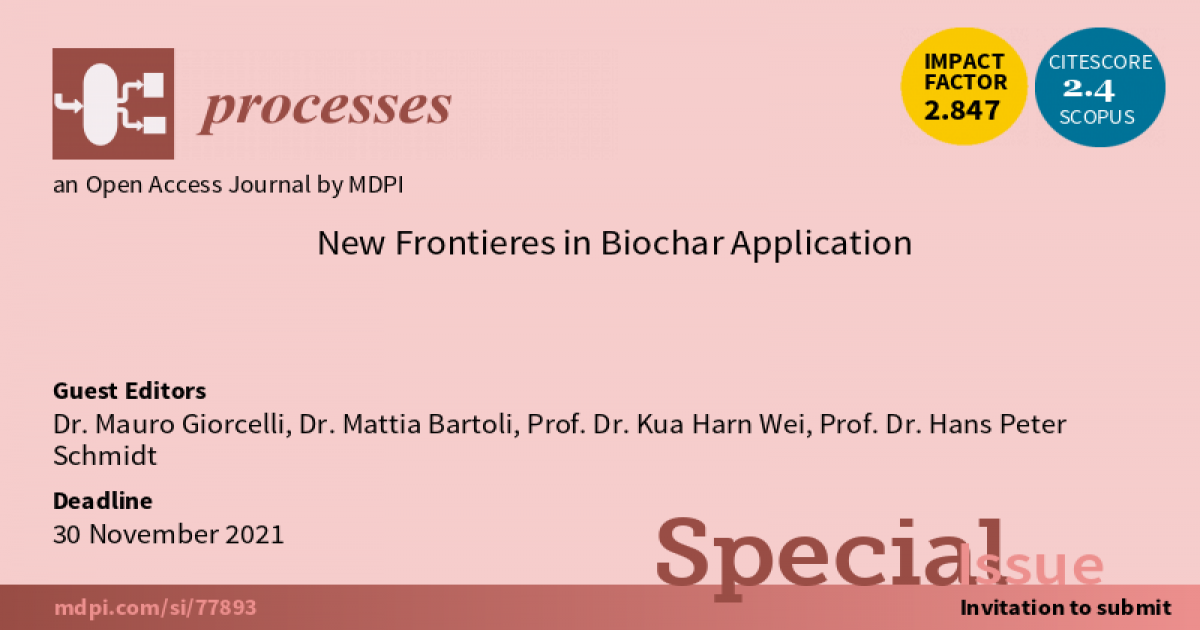- 2.8Impact Factor
- 5.5CiteScore
- 16 daysTime to First Decision
New Frontieres in Biochar Application
This special issue belongs to the section “Environmental and Green Processes“.
Special Issue Information
Dear Colleagues,
Sustainability will drive our choices in the future. Indeed, the quest for sustainability is already starting to transform the competitive landscape, which will force companies to change the way they think about products, technologies, processes, and business models. The key to progress, particularly in times of economic crisis, is innovation. In this scenario, researchers have a key role.
Biochar, a biomass-derived carbon material, has been demonstrated to be a possible material to promote sustainability in different fields from composite production where biochar is used as eco-friendly alternative to oil-derived carbon materials, to the use of biochar in all the fields where other carbon materials are used.
Respect for our world imposes on researchers the need to promote new ways in their research fields oriented to eco-friendly solutions for new generations, to reduce oil addiction using new materials, and to promote the reuse and transformation of waste materials. In recent years, biochar has been presented as a possible key material to apply in these fields. Biochar is derived from waste biomasses and it is used as a substitute for oil-derived carbon materials in several applications.
This Special Issue aims to:
- Explore all the new possible applications in the field of biochar. In particular, papers where biochar is the key factor for innovative applications that promote sustainability will be accepted.
- Provide an up-to-date picture of recent advances and outstanding innovations in the field of biochar applications. Studies in different fields where biochar is the main actor will be welcome.
Dr. Mauro Giorcelli
Dr. Mattia Bartoli
Prof. Dr. Kua Harn Wei
Prof. Dr. Hans Peter Schmidt
Guest Editors
Manuscript Submission Information
Manuscripts should be submitted online at www.mdpi.com by registering and logging in to this website. Once you are registered, click here to go to the submission form. Manuscripts can be submitted until the deadline. All submissions that pass pre-check are peer-reviewed. Accepted papers will be published continuously in the journal (as soon as accepted) and will be listed together on the special issue website. Research articles, review articles as well as short communications are invited. For planned papers, a title and short abstract (about 250 words) can be sent to the Editorial Office for assessment.
Submitted manuscripts should not have been published previously, nor be under consideration for publication elsewhere (except conference proceedings papers). All manuscripts are thoroughly refereed through a single-blind peer-review process. A guide for authors and other relevant information for submission of manuscripts is available on the Instructions for Authors page. Processes is an international peer-reviewed open access monthly journal published by MDPI.
Please visit the Instructions for Authors page before submitting a manuscript. The Article Processing Charge (APC) for publication in this open access journal is 2400 CHF (Swiss Francs). Submitted papers should be well formatted and use good English. Authors may use MDPI's English editing service prior to publication or during author revisions.
Keywords
- biochar
- carbon materials
- composites
- biochar production

Benefits of Publishing in a Special Issue
- Ease of navigation: Grouping papers by topic helps scholars navigate broad scope journals more efficiently.
- Greater discoverability: Special Issues support the reach and impact of scientific research. Articles in Special Issues are more discoverable and cited more frequently.
- Expansion of research network: Special Issues facilitate connections among authors, fostering scientific collaborations.
- External promotion: Articles in Special Issues are often promoted through the journal's social media, increasing their visibility.
- e-Book format: Special Issues with more than 10 articles can be published as dedicated e-books, ensuring wide and rapid dissemination.

